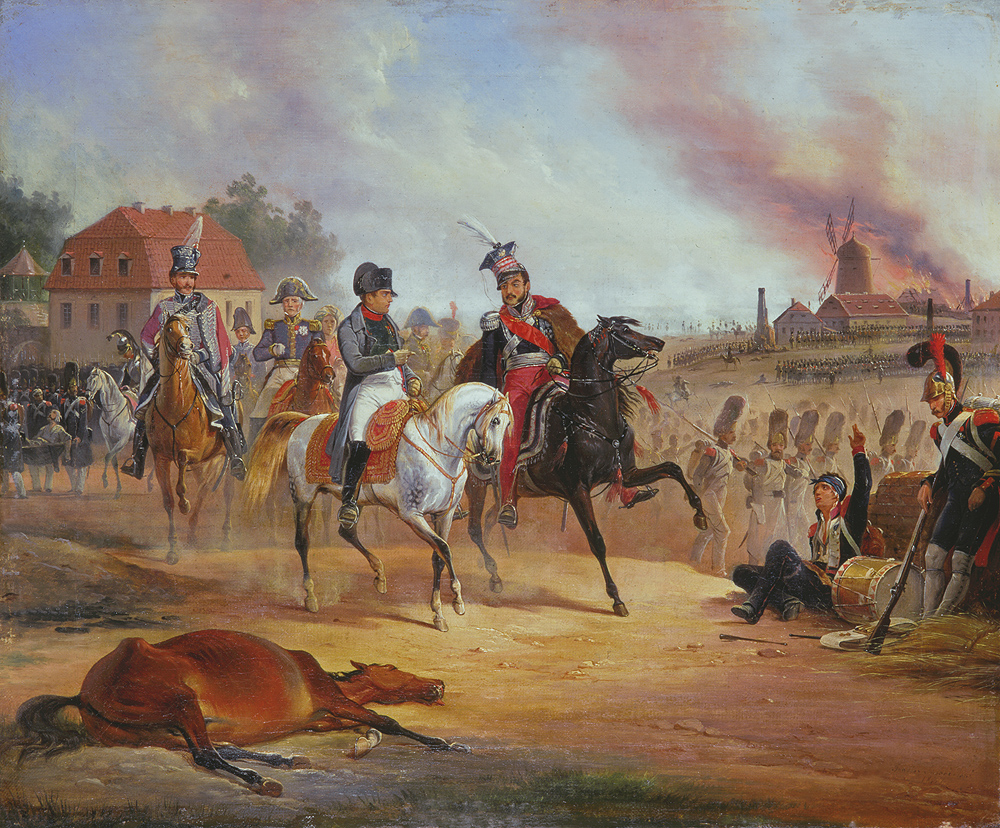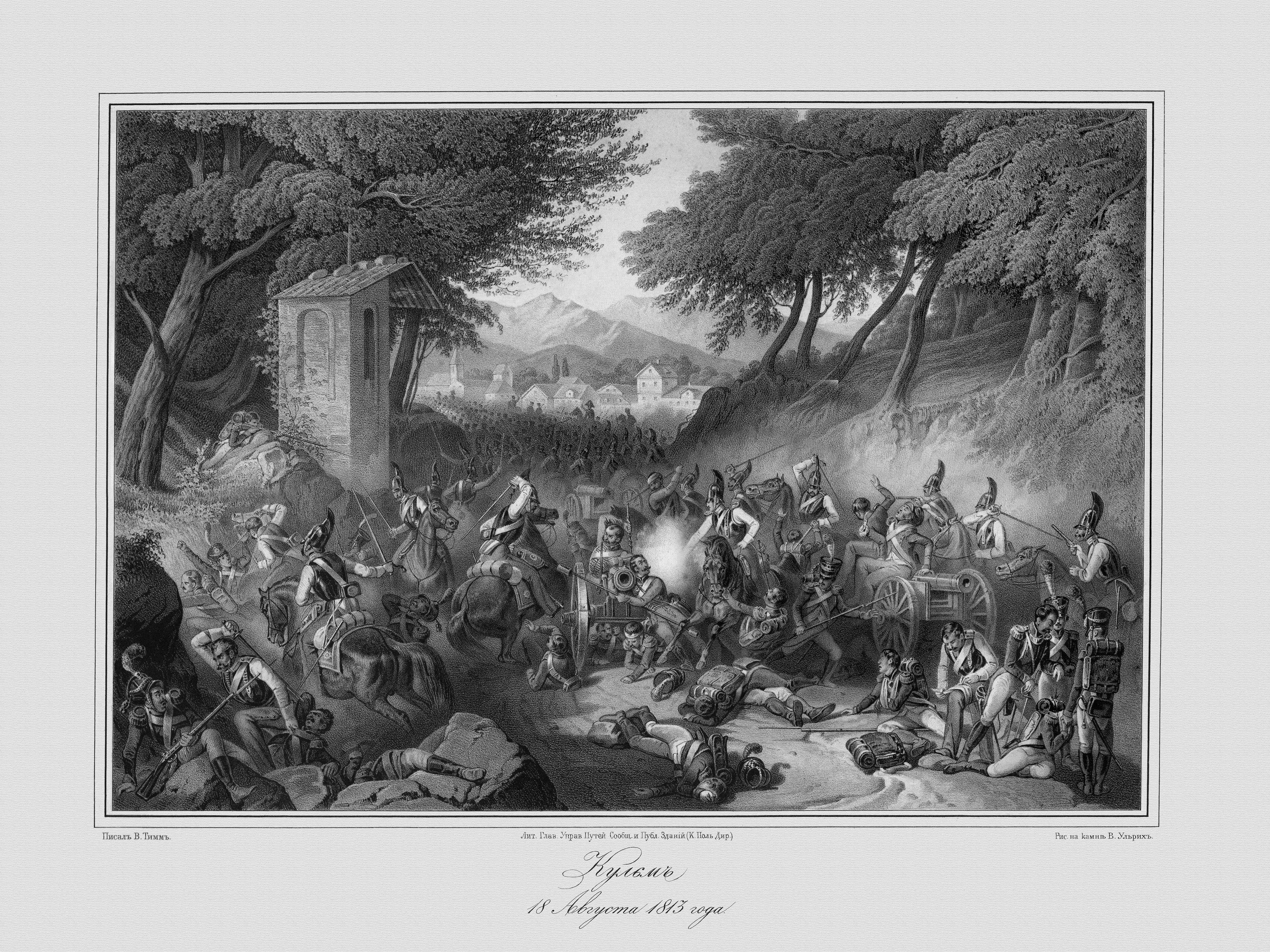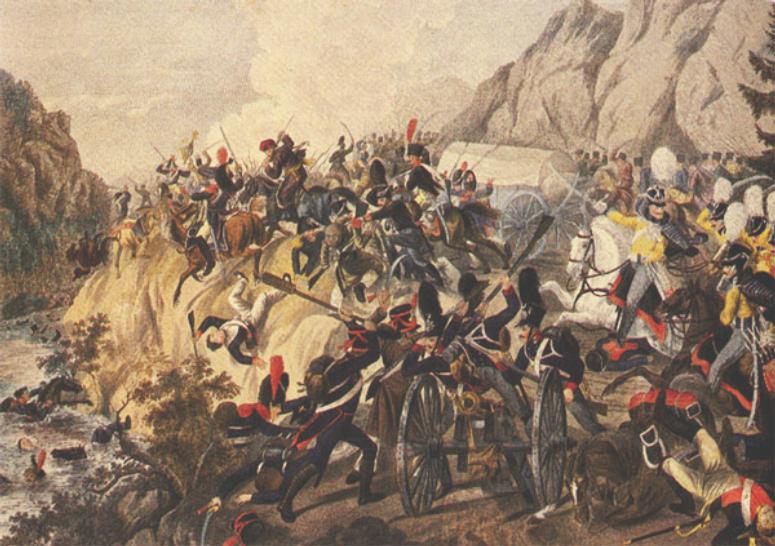|
Battle Of Möckern
The Battle of Möckern (or Dannigkow) was a series of heavy clashes between allied Prusso-Russian troops under Wittgenstein and Napoleonic French forces south of Möckern. It occurred on 5 April 1813. It ended in a French defeat and formed the successful prelude to the "Liberation War" against Napoleon (the German name for the German theatre of the War of the Sixth Coalition). Context In winter 1812, Napoleon had suffered a heavy defeat before Moscow upon which Prussia began to consider giving up its enforced alliance with the French. It signed the Convention of Tauroggen with Russia on 30 December 1812, stipulating neutrality between them, and then on 27 March 1813 both powers declared war on France. Course Meanwhile, in March 1813, the Allied armies decided to attack French forces in Magdeburg so that they could then cross the River Elbe and advance westwards. Troops were also sent off under the command of the Prussian generals Friedrich Wilhelm von Bülow, Karl ... [...More Info...] [...Related Items...] OR: [Wikipedia] [Google] [Baidu] |
German Campaign Of 1813
The German campaign () was fought in 1813. Members of the Sixth Coalition, including the German states of Austria and Prussia, plus Russia and Sweden, fought a series of battles in Germany against the French Emperor Napoleon, his marshals, and the armies of the Confederation of the Rhine – an alliance of most of the other German states –, which ended the domination of the First French Empire. After the devastating defeat of Napoleon's ''Grande Armée'' in the Russian campaign of 1812, Ludwig Yorck von Wartenburg, Johann Yorck – the general in command of the ''Grande Armée'''s German auxiliaries (') – declared a ceasefire with the Russians on 30 December 1812 via the Convention of Tauroggen. This was the decisive factor in the outbreak of the German campaign the following year. The spring campaign between France and the Sixth Coalition ended inconclusively with a summer truce (Truce of Pläswitz). Via the Trachenberg Plan, developed during a period of ceasefire in the sum ... [...More Info...] [...Related Items...] OR: [Wikipedia] [Google] [Baidu] |
Battle Of Bautzen (1813)
In the Battle of Bautzen (20–21 May 1813), a combined Prusso-Russian army, retreating after their defeat at Battle of Lützen (1813), Lützen and massively outnumbered, was pushed back by Napoleon but escaped destruction. Some sources claim that Marshal Michel Ney failed to block their retreat. The Prussians were led by General Gebhard Leberecht von Blücher, and the Russians by General Peter Wittgenstein. Prelude The Prusso-Russian army was in a full retreat following their defeat at the Battle of Lützen (1813), Battle of Lützen. Finally, generals Wittgenstein and Blücher were ordered to stop at Bautzen by Tsar Alexander I of Russia, Alexander I and Monarch, King Frederick William III of Prussia, Frederick William III. The Russo-Prussian army was nearly 96,000 strong, but Napoleon had 144,000. Wittgenstein formed two strong defensive lines east of the River Spree, with the first holding strongpoints in villages and along hills and the second holding the bridges behind ... [...More Info...] [...Related Items...] OR: [Wikipedia] [Google] [Baidu] |
Battle Of Hanau
The Battle of Hanau was fought from 30 to 31 October 1813 between Karl Philipp von Wrede's Austro-Bavarian corps and Napoleon's retreating French during the War of the Sixth Coalition. Following Napoleon's defeat at the Battle of Leipzig earlier in October, Napoleon began to retreat from Germany into France and relative safety. Wrede attempted to block Napoleon’s line of retreat at Hanau on 30 October. Napoleon arrived at Hanau with reinforcements and defeated Wrede’s forces. On 31 October Hanau was in French control, opening Napoleon’s line of retreat. The Battle of Hanau was an important tactical victory allowing Napoleon’s depleted army to retreat onto French soil to prepare to face an invasion of France. Background The Battle of Leipzig, the largest and bloodiest encounter of the Napoleonic Wars, began on 16 October 1813, raged for three days and ended with a decisive victory for the Sixth Coalition. Napoleon was forced to abandon central Germany to the coa ... [...More Info...] [...Related Items...] OR: [Wikipedia] [Google] [Baidu] |
Battle Of Leipzig
The Battle of Leipzig, also known as the Battle of the Nations, was fought from 16 to 19 October 1813 at Leipzig, Saxony. The Coalition armies of Austria, Prussia, Sweden, and Russia, led by Tsar Alexander I, Karl von Schwarzenberg, and Gebhard von Blücher decisively defeated the ''Grande Armée'' of French Emperor Napoleon Bonaparte. Napoleon's army also contained Polish and Italian troops, as well as Germans from the Confederation of the Rhine (mainly Saxony and Württemberg). The battle was the culmination of the German campaign of 1813 and involved about 560,000 soldiers, 2,200 artillery pieces, the expenditure of 400,000 rounds of artillery ammunition, and 133,000 casualties, making it the largest battle of the Napoleonic Wars, and the largest battle in Europe prior to World War I. Decisively defeated, Napoleon was compelled to return to France while the Sixth Coalition kept up its momentum, dissolving the Confederation of the Rhine and invading France early the ... [...More Info...] [...Related Items...] OR: [Wikipedia] [Google] [Baidu] |
Battle Of Wartenburg
The Battle of Wartenburg () took place on 3October 1813 between the French IV Corps (Grande Armée), IV Corps commanded by General Henri Gatien Bertrand and the Allied Army of Silesia, principally the I Corps of General Ludwig Yorck von Wartenburg, Ludwig von Yorck. The battle allowed the Army of Silesia to cross the Elbe, ultimately leading to the Battle of Leipzig. Prelude Following his defeat at the battle of Dennewitz, Marshal Ney withdrew his army to defensive positions along the Elbe. The allied Army of the North, under the command of Charles XIV John of Sweden, Crown Prince Charles John of Sweden (formerly French Marshal Bernadotte), followed them cautiously but made no serious effort to cross the river. To the east, Gebhard Leberecht von Blücher, Marshal Blücher made a bold march skirting Napoleon's position in Dresden to join his Army of Silesia with the Army of the North, cross the Elbe, and threaten Napoleon's communications with France. Major von Rühle was ta ... [...More Info...] [...Related Items...] OR: [Wikipedia] [Google] [Baidu] |
Combat Of Roßlau
The Combat of Rosslau was fought in the War of the Sixth Coalition on 29 September 1813, near Rosslau, Germany. Michel Ney attacked the Swedish bridgehead at the Elbe, to stop the Army of the North from crossing the river. The Swedish commander Johan August Sandels counterattacked and chased the French for before being forced to retire himself. About 350 Swedes were dead and wounded while the French had 600 losses. The battle had no strategic effects, but it was one of very few times in the war that a Swedish force was fully committed in battle. Background A French force under Michel Ney had received orders from Napoleon I to attack the Swedish bridgehead over the Elbe river, at Rosslau, to stop the Army of the North (under the Swedish Crown Prince Charles John) from reaching Leipzig. After having fought a couple of skirmishes for control over Dessau, Ney marched his troops of about 7,000–8,000 men towards the Swedish left flank. The Swedes had around 4,000–4,500 men i ... [...More Info...] [...Related Items...] OR: [Wikipedia] [Google] [Baidu] |
Battle Of Altenburg
The raid at Altenburg on 28 September 1813 took place during the War of the Sixth Coalition's German Campaign of 1813. The raid was carried out by the ''Streifkorp'' under the command of Saxon General Johann von Thielmann commanding seven regiments of Cossacks, a squadron each of Saxon Hussars and Dragoons, and a detachment of '' Saxon Freikorps'' numbering about 1,500 cavalry. The objective of the raid was to attempt harassment of the French lines of communication 25 miles (45 km) south of Leipzig shortly before the Battle of Leipzig. The Austrian contingent was commanded by Emmanuel Mensdorff and the Russian contingent of Cossacks by Matvei Platov. Background The battle was the culmination of a raid in which Thielmann cavalry successfully attacked Napoleon's lines of communications along the roads between Erfurt and Leipzig in the Saale valley. Battle Thielmann completely surprised and routed a larger force of French cavalry, including Cavalry of the Imperi ... [...More Info...] [...Related Items...] OR: [Wikipedia] [Google] [Baidu] |
Battle Of The Göhrde
The Battle of the Göhrde took place during the War of the Sixth Coalition on 16 September 1813 between French and Coalition troops at Göhrde, Germany. The French troops were defeated and withdrew to Hamburg. Site The battle occurred near what is now the Göhrde State Forest (''Staatsforst Göhrde''), near Dannenberg, near Lüneburg. At that time this area belonged to the electorate of Braunschweig-Lüneburg (Hanover), which had been occupied by the French since 1803. Prelude In March 1813, Russian troops under Friedrich Karl von Tettenborn forced the French out of Hamburg and some northern areas of Hanover. In the wake of Prussia's reentry into the war against France, the eastern areas of Hanover also rose against Napoleon. Wallmoden then received overall command of all the Allied troops on the Lower Elbe: troops from Prussia, Russia, the United Kingdom, Hanover, Hamburg, Mecklenburg and Sweden, including the Russian German legion, the Lützow Free Corps, the Hans ... [...More Info...] [...Related Items...] OR: [Wikipedia] [Google] [Baidu] |
Battle Of Dennewitz
The Battle of Dennewitz () took place on 6September 1813 between French forces commanded by Marshal Michel Ney and the Sixth Coalition's Allied Army of the North commanded by Charles XIV John of Sweden, Crown Prince Charles John of Sweden, Friedrich Wilhelm Freiherr von Bülow, Friedrich Wilhelm von Bülow and Bogislav Friedrich Emanuel von Tauentzien, Bogislav von Tauentzien. It occurred in Dennewitz, a village in the Prussian province of Brandenburg, near Jüterbog, southwest of Berlin. The battle marked a turning point in the German Campaign of 1813 as not only did the Allied victory end Napoleon's hopes of capturing Berlin and knocking Prussia out of the war, but the severity of the French defeat, inflicted by a primarily Prussian force, also led to the erosion of fidelity of German allies to the Napoleonic cause. The French losses, and consequent diplomatic reverses, that resulted from Dennewitz contributed greatly to Napoleon's defeat a month later at the Battle of Leipz ... [...More Info...] [...Related Items...] OR: [Wikipedia] [Google] [Baidu] |
Battle Of Kulm
The Battle of Kulm was fought near the town Kulm () and the village Přestanov in northern Bohemia. It was fought on 29–30 August 1813, during the War of the Sixth Coalition. A French corps under General Dominique Vandamme attacked Alexander Osterman-Tolstoy's Russian corps on 29 August. The next day, Friedrich von Kleist's Prussian corps hit Vandamme in the rear while Russian and Austrian reinforcements attacked the French front and left. Vandamme was defeated with the loss of between 13,000 and 25,000 men and 82 guns. Background Following the French victory at Dresden, Vandamme pursued the retreating allies. Napoleon sent Marshals Gouvion Saint Cyr and Auguste Marmont to support Vandamme's corps. With Vandamme in advance, Saint Cyr's and Marmont's corps brought up the rear. Vandamme caught up with Alexander Ivanovich Ostermann-Tolstoy's forces near the town of Kulm, eight kilometres northwest of Aussig (Ústí nad Labem, now in the Czech Republic). Battle On ... [...More Info...] [...Related Items...] OR: [Wikipedia] [Google] [Baidu] |
Battle Of Dresden
The Battle of Dresden (26–27 August 1813) was a major engagement of the Napoleonic Wars. The battle took place around the city of Dresden in modern-day Germany. With the recent addition of Austria, the Sixth Coalition felt emboldened in their quest to expel the French from Central Europe. Despite being heavily outnumbered, French forces under Napoleon scored a victory against the Army of Bohemia led by Generalissimo Karl von Schwarzenberg. However, Napoleon's victory did not lead to the collapse of the coalition, and the weather and the uncommitted Russian reserves who formed an effective rear-guard precluded a major pursuit. Three days after the battle, the Coalition surrounded and destroyed a French corps advancing into their line of withdrawal at the Battle of Kulm. Prelude On 16 August, Napoleon had sent Marshal Saint-Cyr's corps to fortify and hold Dresden in order to hinder coalition movements and to serve as a possible base for his own manoeuvres. He planned to ... [...More Info...] [...Related Items...] OR: [Wikipedia] [Google] [Baidu] |
Battle Of The Katzbach
The Battle of the Katzbach on 26 August 1813, was a major battle of the Napoleonic Wars between the forces of the First French Empire under Marshal of France, Marshal Étienne-Jacques-Joseph-Alexandre MacDonald, MacDonald and a Imperial Russia, Russo-Kingdom of Prussia, Prussian army of the Sixth Coalition under Prussian Marshal Graf (Count) Gebhard Leberecht von Blücher, von Blücher. It occurred during a heavy thunderstorm at the Kaczawa, Katzbach river between Legnickie Pole, Wahlstatt and Legnica, Liegnitz in the Prussian province of Silesia. Taking place the same day as the Battle of Dresden, it resulted in a Coalition victory, with the French retreating to Saxony. Prelude Gebhard Leberecht von Blücher, Blücher ordered the Army of Silesia to advance on 13 August, before the Truce of Pläswitz could conclude on 17 August. In a series of running fights, the Allied army beat back the confused French, who did not anticipate that the Allies would break the armistice so braz ... [...More Info...] [...Related Items...] OR: [Wikipedia] [Google] [Baidu] |



